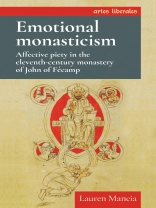Medievalists have long taught that highly emotional Christian devotion, often called ‘affective piety’, appeared in Europe after the twelfth century and was primarily practiced by communities of mendicants, lay people and women.
Emotional monasticism challenges this view. The first study of affective piety in an eleventh-century monastic context, it traces the early history of affective devotion through the life and works of the earliest known writer of emotional prayers, John of Fécamp, abbot of the Norman monastery of Fécamp from 1028–78. Exposing the early medieval monastic roots of later medieval affective piety, the book casts a new light on the devotional life of monks in Europe before the twelfth century and redefines how medievalists should teach the history of Christianity.
Innehållsförteckning
Introduction
1 Reforming the reader’s interior: defining emotional reform in John of Fécamp’s Confessio theologica
2 Dicta mea sunt dicta patrum? Tradition and innovation in John’s writing
3 Reforming the monastic community: the uses of John’s devotional method within the walls of Fécamp
4 Reforming monks in the temporal world:John’s devotional principles cultivated in the Anglo-Norman landscape
5 John’s medieval legacy: the monastic roots of affective piety
Conclusion
Index
Om författaren
Lauren Mancia is Assistant Professor of History at Brooklyn College, City University of New York












